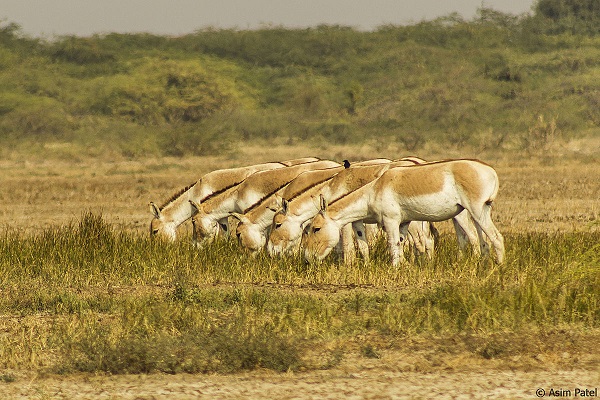At first instance, one thought will blink in one’s mind that, what would be there to see in a desert? But after visiting the Little Rann of Kutch, the fillings will definitely be reversed.

The Little Rann of Kutch is an area of 4953 Sq. Kms, which is declared as Wild Ass (Equus Heminous Khur) Sanctuary in 1973. Though it is a flat, salt cracked vast barren desert, it consist very rare and rich bio diversity. It is the only place on earth, which is remained as last habitat of Wild Asses. Previously it was a shallow portion of Gulf of Kutch, formed by the process of siltation of marine estuary. During winter, cold wind blows and nights are chilled. In summer time, hissing sand storms and the temperature rises high up to 47*C. During monsoon, the discharge of rivers and rain water along with sea water – blown up due to south west winds, the whole area converts into a shallow sheet of water until October- November.
An average rain is around 300mm, which goes down to just 100mm in drought years. Rains are erratic and mostly every next year is a drought year. The climate remains dry for most of the year. Temperature variation is very high and ranges from 4*C to 47*C. Salt impregnated desert is very sterile and devoid of any vegetation. Only the fringes and elevated islands possess trees like prosopis and salvadora and unique saline grass species such like sporobolus, sueda, theglo and allurops etc. which proves a nutritious fodder base for wild herbivorous. The Little Rann of Kutch is having a very huge (more than 2500) Wild Ass (Equus Heminous Khur) population. This sub specie of Khur is seen only here in the world. And this makes Little Rann of Kutch an important and remarkable place as a Gene Pool of wild ass. The sanctuary also inhabits other mammals like Blue Bull, Chinkara, Wild Boar, Black Buck, Jackal, Fox, Desert Fox, Hare, Jungle Cat, Desert Cat, Hyena and Spiny Tailed Lizard. As the area becomes a vast wet-land in monsoon, it attracts many migratory birds like Flamingo, Pelicans, Herons, Egrets, Storks, Terns, Ducks and other Waders. Many raptors like Owl, Falcon, Harrier, Eagle and Buzzard also are regular visitors of the rann. Also small migratory birds like common crane, lark and pipit can be seen in large numbers. The Avi Fauna becomes richer with presence of some rare birds like Caspian Tern, Sociable Lapwing, Lesser Florican and Houbara Bustard.
The place is easily approachable from Ahmedabad and one can get reasonable budget accommodation in nearby area too. So why don’t you think to treasure some unforgettable moments of life and enjoy the sheer pristine beauty of Little Rann of Kutch?